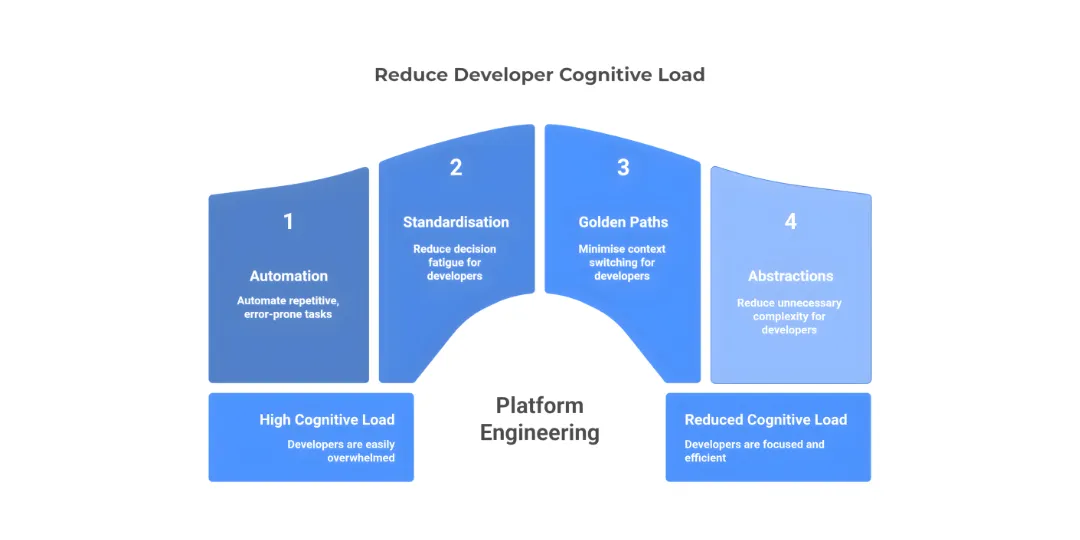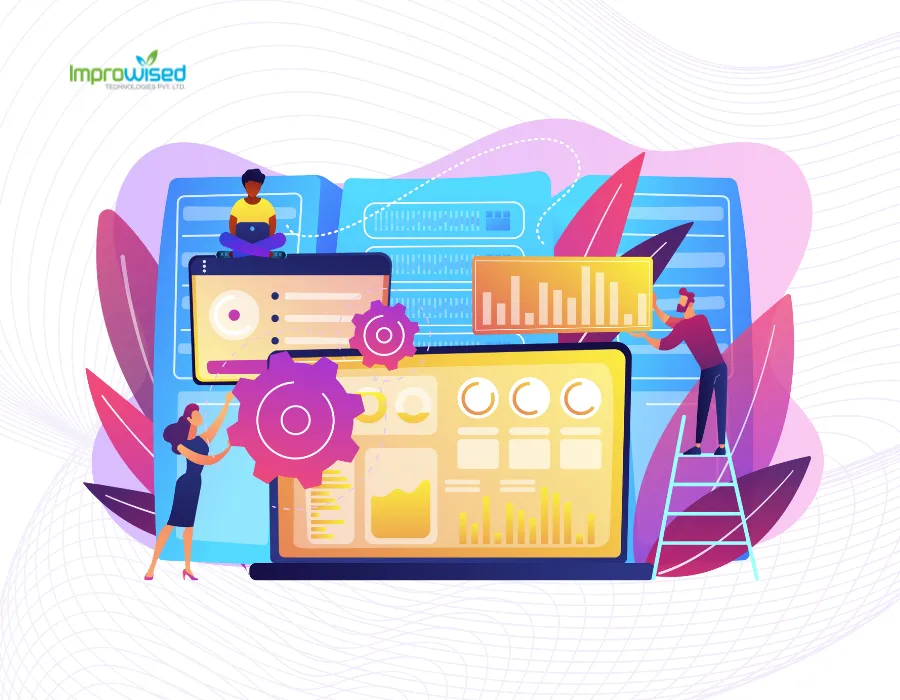November 21, 2025
How Platform Engineering Reduces Developer Cognitive Load: Best Tools & Strategies

By Shyam Kapdi
Improwised Technologies Pvt. Ltd.
The foundation of effective platform engineering strategies is lowering the cognitive load of developers, not just for personal efficiency gains but also to change the basic structure of modern software companies.
Engineering leaders are under tremendous pressure to provide streamlined, user-friendly infrastructure that frees up cognitive resources for creative and business-critical tasks as digital complexity increases across multi-cloud, hybrid, and distributed environments.
The structural response to this crisis has been platform engineering, which is an organisational strategy to systematically reduce cognitive load instead of a tooling initiative.

Understanding Developer Cognitive Load: Psychological Foundations
The educational psychology-based Cognitive Load Theory (CLT) fits in surprisingly well with modern software teams. Like a CPU with fixed registers and predictable bottlenecks, developers have a limited working memory capacity. Performance decreases exponentially instead of linearly when overloaded.
The complexity of the task - debugging a distributed system - is referred to as intrinsic load. Poor design, like unclear CI pipelines or inconsistent documentation, creates unnecessary load. The advantageous mental effort that allows deep expertise and schema building is known as Germane load.
CLT identifies three types of load:
Intrinsic Load: This is the task’s inherent complexity. For example, it will always be challenging to build a distributed event-driven system. This load cannot be removed, but you can select more suitable abstractions.
Extraneous Load: Poor documentation, unclear APIs, tribal knowledge, distributed tooling, and confusing CI errors are the avoidable friction points. The majority of companies lose productivity here.
Germane Load: The mental work required to discover reusable patterns and make important design choices is known as the “good” load.
How Platform Engineering Alleviates Cognitive Load
Platform engineering is about exposing golden paths that are optimised for the business while protecting developers from repetitive low-level details. It is not about “tooling for tooling’s sake.” Distractions are eliminated by automation (e.g., infrastructure orchestration using Terraform or Pulumi), while standardised self-service portals (like Internal Developer Platforms) only offer the options that are required and have been pre-validated by architectural patterns.
-
Automate repetitive and error-prone tasks, like deployment workflows using GitOps and environment provisioning through Terraform or Pulumi.
-
Build and maintain “golden paths”: self-service workflows and modular templates that encode best practices as defaults, reducing unnecessary decision-making.
-
Abstraction isn’t about hiding detail completely, but exposing only the controls developers need, when they need them.
Automation Removes Repetitive Thinking: Every time a developer manually configures an environment, writes deployment YAML, or troubleshoots the same IAM bug, they’re burning cognitive capacity on work that adds no creative value.
Standardisation Reduces Decision Fatigue: Developers don’t need 20 ways to deploy a service. They need one intuitive, battle-tested path.
Golden Paths Minimise Context Switching: Golden paths turn “choose your own adventure” engineering into guided, high-success workflows. They eliminate hours of low-value problem-solving.
Abstractions Reduce Unnecessary Complexity: Well-designed platforms don’t hide power - they hide decisions developers shouldn’t have to care about right now.
Also Read: 7 Signs Your Organization Needs Platform Engineering
Best Tools and Technologies in 2025 & Beyond to Reduce Cognitive Load
Backstage and Port are examples of internal developer platforms that give teams access to discoverable and customisable lists and automate environment setup through standardised service templates. Infrastructure states are automated at scale by Terraform and GitOps tools, but intelligent layers are starting to appear: Cody and GitHub Copilot’s enterprise integrations are examples of AI-powered developer assistants that do more than just autocomplete code; they also proactively anticipate intent, alert users to architectural drift, and automatically generate secure configurations.
By providing a service directory, role-based access, and cross-environment management, platforms such as Backstage or Port provide unified developer experiences.
Developers no longer have to spend hours on ad hoc documentation or tribal knowledge because of these platforms, which promote discoverability.
Internal Developer Platforms (IDPs)
- Backstage: Best for organisations that need a structured, catalogue-driven service ecosystem.
- Port: Better for orgs that want faster setup, dynamic workflows, and non-rigid metadata modelling.
Automation and Infrastructure Tools
- Terraform is no longer just IaC - it’s the “shared language” of infra reasoning.
- GitOps tools (ArgoCD, Flux) reduce deployment uncertainty by giving developers behavioural consistency.
Adopt AI-Powered Developer Assistants
- Modern AI tools like Copilot Enterprise don’t stop at code completion - they anticipate architecture drift, suggest optimal patterns, and flag security misconfigurations preemptively.
- Integration with documentation, configuration management, and observability closes feedback loops and makes critical context instantly accessible.
Tool Integration and Ecosystem Management
Adding tools appears to increase fragmentation rather than decrease cognitive overhead. Connective middleware, declarative integration contracts, and UX orchestration are some of the unique platform engineering techniques that promote ecosystem integration. Multi-cloud sprawl is transformed into a smooth developer journey through distributed tracing, unified identity providers, and consistent interface paradigms across environments.
-
Intentionally integrate authentication, observability, and workflow orchestration - consistency in look, feel, and process dramatically shortens time-to-productivity for new hires.
-
Smart middleware and declarative interfaces bridge legacy and cloud-native systems, converting multi-cloud complexity into seamless developer journeys.
-
Success metric: New devs should deploy value-adding code in days, not weeks.
Measuring and Improving Developer Experience
It takes more than tales to measure the impact of cognitive load. The HEART framework converts subjective developer experiences into useful KPIs by monitoring Happiness, Engagement, Adoption, Retention, and Task Success. Leading companies use platform usage analytics, incident response times, and NPS surveys to identify areas of friction. They then conduct platform-driven experiments to determine which changes best lower the load.
-
Employ frameworks like HEART - not just as vanity metrics but as diagnostic tools, capturing friction points with quantitative rigour.
-
Instrument all developer touchpoints with usage analytics and feedback collectors; continuously run experiments to validate which changes reduce load in practice.
Also Read: How Platform Engineering Transforms Developer Experience?
Organisational and Cultural Impacts
Platforms are successful due to organisational psychology as well as technology. Cognitive load decreases when developers have autonomy, which includes the freedom to select tools, use resources on their own, and experiment safely. Platforms have to enable simple error recovery, clear documentation, and team-driven process updates without disciplinary oversight in order to ensure psychological safety.
Instead of issuing top-down directives that frequently backfire, effective change management requires cross-functional buy-in, iterative rollout plans, and leadership proactively removing barriers.
-
Create self-service platforms with strong guardrails, so developers can iterate with confidence (and recover from mistakes easily).
-
Foster a culture where experimenting and reporting platform issues is rewarded, not punished - collaborative improvement is a force multiplier.
Security and Compliance Integration
When security and compliance are poorly implemented, they increase cognitive load by requiring developers to manage conflicting requirements, approval workflows, manual audits, and never-ending checklists while creating features. Platform engineering offers the chance to integrate security and compliance so smoothly that doing the right thing is simpler than doing the wrong thing, lowering cognitive load and enhancing security posture.
-
Instead of overloading developers with noise, automate security checks and compliance gates within pipelines to only make interventions when absolutely required.
-
To reduce the requirement for manual “checkbox” fatigue, encode requirements using Policy-as-Code frameworks.
The traditional model forces security checks as manual, external gates, creating a massive extraneous load and friction. Platform Engineering flips this by implementing Secure-by-Default and Automated Compliance.
Cross-Team Collaboration and Cognitive Load
When platform engineering is combined, it lessens the cognitive load on developers as well as QA, operations, and security. Event-driven triggers, unified collaboration areas, and automated pipeline handshakes integrate team workflows and lessen constant handoff friction. Common toolchains and shared platform visibility are directly responsible for measurable drops in incident rates and handling times observed in case studies of extensive DevOps transformations.
-
Dev, QA, Sec, and Ops teams can all work from the same contextual “source of truth” by using shared platforms to coordinate integrations, triggers, and notifications.
-
Case studies reveal sharp reductions in incident rates and lead times when organisations harmonise toolchains and workflows under a unified platform layer.
Challenges and Pitfalls
Not all methods of reducing cognitive load are beneficial. Over-automation runs the risk of causing catch-22 support loops, limiting developer flexibility, or making platforms opaque. When platforms multiply without a plan or when governance becomes so inflexible that genuine autonomy is lost, tool fatigue sets in. In order to carefully balance control and creative freedom, skilled platform architects keep an eye on tool adoption velocity, platform usage, and developer sentiment over time.
-
Over-automation and poorly governed platforms can stifle creativity - right-size governance to balance control and autonomy.
-
Tool fatigue arises when integrations are half-baked or documentation is stale. Measure adoption velocity, usage patterns, and sentiment; prune aggressively.
Future Trends
Proactively measuring and predicting cognitive load is the next big step. Emerging platforms’ AI systems use behavioural telemetry analysis to predict burnout, suggest productive work schedules, and dynamically rearrange procedures to best suit developer preferences. Before cognitive overload causes context thrashing or regression errors, predictive analytics has already identified probable underlying causes. Best-in-class engineering companies will soon consider this type of “DX-centric AI” standard practice.
-
In the near future, the most advanced platforms will predict cognitive bottlenecks, optimise developer workflows in real-time, and initiate dynamic adjustments ahead of overload.
-
Proactive, AI-powered DX management will quickly establish itself as the industry standard and set high-performing organisations apart.
Conclusion
Reducing developer cognitive load is crucial for resilient delivery pipelines and sustainable engineering cultures; it is not a checkbox. Before developing platform strategies that include automation, integration, security, and ongoing feedback, leaders should first audit current workflows against the cognitive load theory. Real autonomy, “golden paths,” and the integration of various tools are the first achievements. In the end, platform engineering services is the art of reducing barriers to excellence so that developers can push the envelope of what is possible.

November 19, 2025
Unlocking Developer Potential: How Platform Engineering Transforms Developer Experience

By Shyam Kapdi
Improwised Technologies
Pvt. Ltd.


By Shyam Kapdi
Improwised Technologies
Pvt. Ltd.

November 14, 2025
How to Build a High-Impact Internal Developer Platform: Step-by-Step Blueprint, Tools, and Best Practices

By Shyam Kapdi
Improwised Technologies
Pvt. Ltd.
Optimize Your Cloud. Cut Costs. Accelerate Performance.
Struggling with slow deployments and rising cloud costs?
Our tailored platform engineering solutions enhance efficiency, boost speed, and reduce expenses.
